Enterprise Software Development: Solutions for Business Success

Enterprise software development is defined as the intricate process of developing particular applications needed in any business to make it a success. Understanding its definition, costs and trends is helpful in making correct decisions oriented on a company’s strategic objectives. Cloud computing, AI integration and many more trends are now embraced by companies and knowledge about them helps to get an advantage.
Companies are now embracing cloud computing, AI integration, and many other trends — partnering with a custom software development company helps them gain a competitive advantage.
Developers within corporate software development need to be engaged in building solutions for clients with particular business needs. Choosing the right set of developers who share a view of your goals is bound to give you robust and scalable software. This shall be what will make your enterprise operations efficient and effective.
Enterprise software engineering is the comprehensive solution to all complex business-related issues. While looking for a company to manage your software engineering requirements, seek to know more about their domain experience, innovation capabilities and long-term support. Partnering with the right company might give your business the necessary boost towards long-term success and progress.
What is enterprise software development?
Business software development comprises the designing, implementation and deployment of particular software applications in the enterprise platform for the solution of enterprise needs. Corporate software is usually developed to implement various business flows, process big amounts of information and interact with other applications in the company.
Important types of developing enterprise software represent:
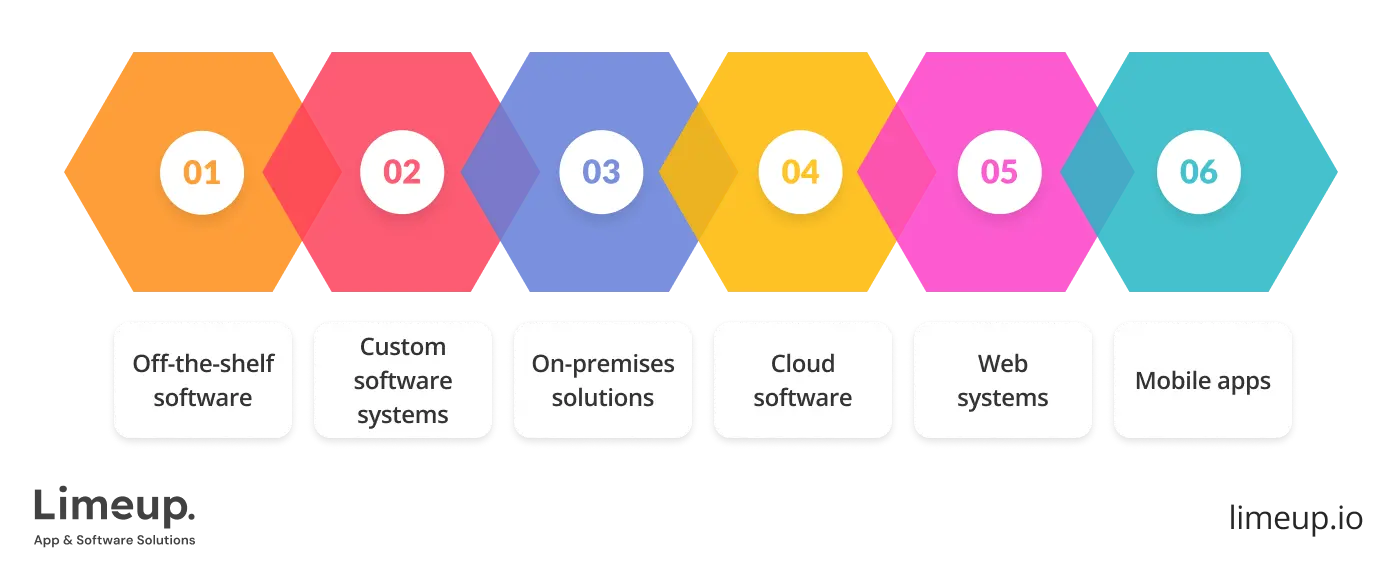
Off-the-shelf software. This position has become popular among businesses looking for a standardized system. At the same time, off-the-shelf modules are supposed to be adjusted and tuned to the business requirements.
Custom business software systems. Corporate software is created from the ground up, designed with specific objectives from the beginning. It involves outsourcing employees for the development and maintenance of the software by an organization or a contractor employed for the purpose.
On-premises solutions. On-premises software is executed on company servers thus the firm is able to retain information within the organization. However, it frequently fails to cover as many people and businesses as may be expected. Updating, expanding and exchange of the data may be quite tiresome and exhausting, but solving these problems and accomplishing scalable and effective solutions is part of learning how to build enterprise software.
Cloud software. Top organizations consider cloud as one of the top strategic technologies for future development. Cloud-first and XaaS will increase abilities and efficiency while lowering complexity of change, while more security is possible in the private clouds.
Web systems. With modern frontend frameworks, enterprise software developer has capacity to easily create fast and responsive business software applications that work great on different types of devices.
Mobile apps. Mobile software has the capability of interfacing with other bigger software systems and at the same time was designed to ease out employees’ operations. The mobile apps for smart phones can give the detailed direction to drivers or the mobile warehouse apps on the tablets can help in searching some items and maintaining the records.
5 phases in corporate software development
Exceptional projects require an exceptional vision at the start. The development of any complex system, such as software for the enterprise, needs planning and management up front. It is very critical to be done at the beginning, more so in the case when there are a number of different processes being run concurrently.
While developing enterprise apps, there are certain steps that an enterprise software development firm should adhere to in order to produce quality software right from its conceptual stage to launching time and even beyond. Let’s get started by examining the main considerations that need to be undertaken.
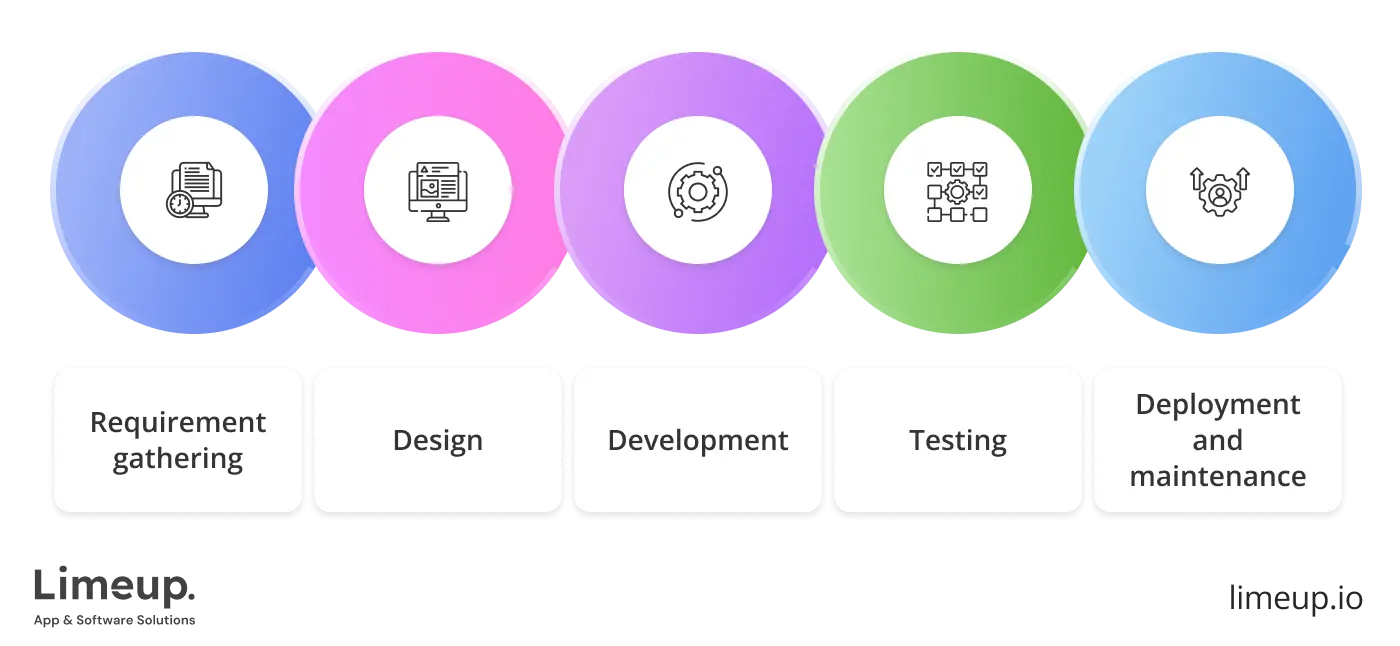
Requirement gathering
Recording and describing the major business processes and how they are currently supported with existing software identification of how the existing IT landscape can support or constrain business processes — are all critical components of the Software Requirements Specification (SRS) document.
Identifying the requirements and issues that the business has regarding the current and ideal business process flows. Whereas evaluating a large scale business plan (e.g., schedule company growth and IT spending plans) might be used to influence architectural and determine the tech stack for the planned software.
At this stage, enterprise developers zero in on risks and ways changes might adversely impact business processes. This might include productivity and time lost while transitioning to new digital processes and training the business users. It is in this regard that meticulous planning can effectively resolve these challenges and lay the way for its smooth implementation and future growth in the creation of software for enterprises.
Design
Design phase of enterprise development software where all the prerequisites are taken into consideration. From the smallest modules to the overall architecture of the program, every minute detail of a project is described and designed. The primary thing here is the SRS script, which was created in the previous process and now it is being used to develop the app. Creation and registration of different components, software management according to the scope and services of the project.
In this process, framework and program architecture are prepared based on the requirements criteria studied in the previous phase. Device design helps in determining overall system architecture and also helps in determining hardware and function specifications. The device architecture requirements serve as guidance on what should be the next step of the model. Data obtained from this step will be taken into the next stage.
Development
The most awaited phase of software development enterprise starts, in which the actual implementation takes place. This is the toughest and most time-consuming procedure of a project. Deliverables from the earlier stage are used in the coding process when developers start building them using the language they opted for in the first step.
Sprints that need to be adhered to in this creation phase are decided within the planning phase itself. An enterprise software development company keeps an eye on the upcoming trends in enterprise application programming. A set of developers are assigned for the delivery task and a Project manager manages the enterprise application development phase.
In case all modules are designed, they are put together and then if everything goes in the right manner, there are no dependency failures or conflicts, you will have a fully working program ready for the next phase in this software development.
Testing
The other sets of important stages came into the picture just after the enterprise app development process was complete. There are also stages for enhancement, wherein the developed product is examined, tested and deployed after the development process.
All these stages use different software development testing methods to test the robustness and reliability of the application. Functionality, performance and security testing methods will be adopted to help identify problems that may arise. Enterprise software developers will be able to fine-tune the software and enhance its performance through such rigorously tested applications in order to ensure problem-free deployment and usage.
Deployment and maintenance
Here the developed software or application is deployed on various platforms or in the enterprise it is created for. While deploying an application, there are primarily two available app stores:
- Apple App Store
- Google Play Store
Ideally, on these platforms, the development company has to pay a yearly fee and comply with the app store guidelines. Additionally, the Apple App Store guidelines are much stricter than those of the Google Play Store. Hence, know the recommendations in advance if you want to make an app for the Apple App Store.
Additionally, an enterprise software deployment cycle can become longer and more complex. The reason is very simple: business software is used in the whole infrastructure — getting down to it, at least a department. In both cases, the time to deploy is way more than deploying an app on any app store, including infrastructural resources and sometimes additional hardware to pull this off.
How to calculate costs for enterprise software engineering?
The cost of huge organization software can be very variable since there are numerous factors to be considered, such as requirements and scope. One can oversimplify this by mentioning the average cost for enterprise software.
Conforming to our experience, most corporate software projects we’ve encountered fall between $100,000 and $750,000. As we’ll delve into later, this price tag covers the whole life cycle of application development, from design to implementation.
To give you a better understanding of where on that spectrum you are, you need to be very clear about what affects the cost of enterprise software. Some of the variables that will likely impact the cost of hiring an enterprise software developer for your custom corporate software solution include:
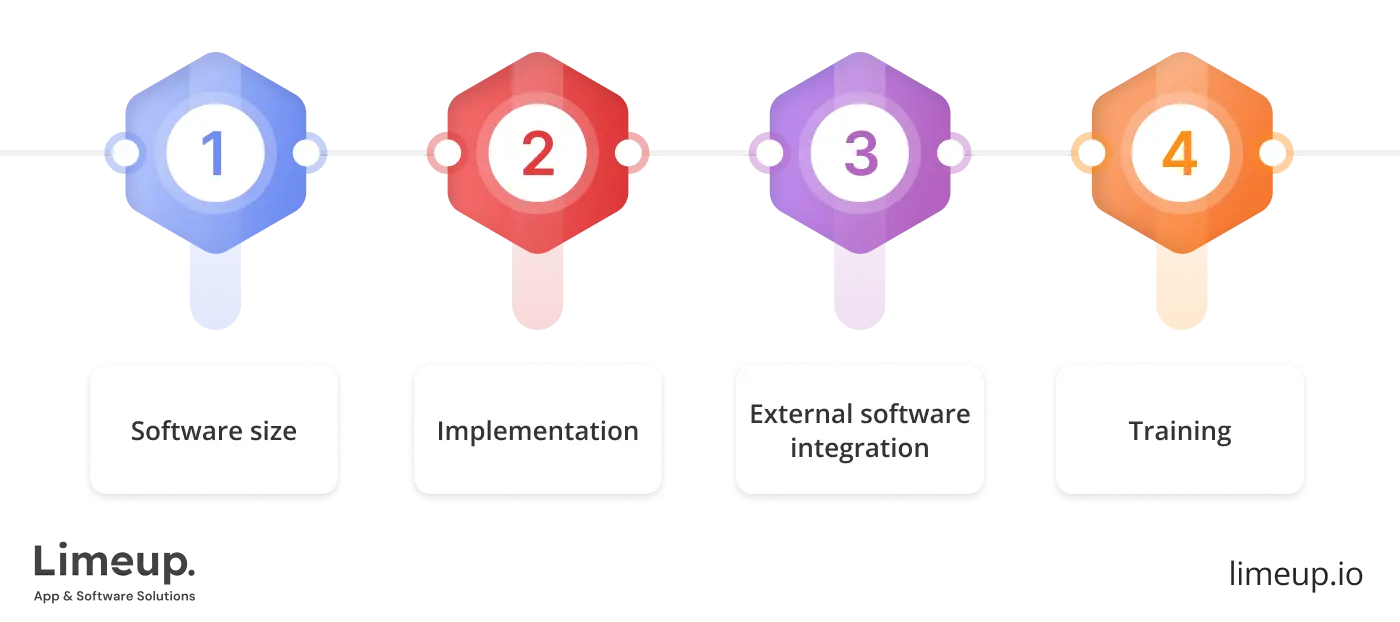
Software size. The price tag of an enterprise system goes directly in proportion to the size of the software. It will only be the well-funded startup, fast-growing mid-sized business, or the multinational that shall be large enough to undertake such an enterprise initiative.
These are big pieces of software dealing with a large number of users with a large number of pages or screens. All of these are the factors that increase the cost of corporate software.
Implementation. There has to be a fair amount of time invested in determining the implementation team. A good number of software development services in the United Kingdom that offer services in software creation also support their client in implementation and maintenance. Some offer fully scripted solutions from the beginning to the end, while there are those who look towards the client to seek assistance elsewhere if needed.
Definition and even decisions about what support services are needed after the product is delivered are necessary. If not made part of an all-in-one package by the enterprise software programmers themselves, it can be unnecessary to make an added payment for hiring a third-party for ongoing support.
External software integration. Having additional software in the equation is not recommended since it brings a lot of factors into consideration. You never actually know how well the other system lets information in or out and what hoops you’ll have to jump through during development.
Less often the integrations are minor and will not take much additional time or effort on the project. Others are fairly difficult especially when the two systems to be integrated are large-scale ones. In these cases, an enterprise software development agency can be a real lifesaver, deftly handling the complexity and smoothing out the integration process.
Outdated and less familiar systems might take longer to use and delay the project — ultimately increasing the cost. It can be seen that the degree of detailed integration required may affect the cost of business software significantly.
Training. In many cases, people have paid much attention to the software that will install your system but have not given any attention to the person who will be educating your staff. When speaking of the total cost of software development for enterprise, one cannot fail to mention training.
As it is always the case with the users, they are bound to experience steep learning curves when they employ new applications. That learning curve can be rather steep, especially if the users have had no previous experience with the complex software or they are not the most computer-literate individuals.
Any initial costs of educating your staff in terms of the right usage of the system are realized. Other expenses are for training, which is especially timely when instruction occurs in-house. Ask the development team about training services in relation to the project or the availability of training services in your organization and factor the cost of training into your budgeting.
So, what is the price of customized business software? The expenses associated with developing software for small-to-mid-sized businesses can vary from $100,000 to $200,000 while the cost for large enterprise projects may exceed these numbers. It is also quite a big outlay even at the lower end of the price bracket. In this case, a quality custom enterprise software engineering will barely take its time to start generating returns on investment.
It is likely possible to develop your budget if it comes within that range, meets the size estimates mentioned above and accounts for the aspects that usually drive up costs.
Building enterprise software vs SaaS
There is a misconception that SaaS and software for businesses refer to the same thing. While both of them focus on processes of implementing software products and their involvement in organizations’ work, they still differ in crucial points that can make them useful for different industries and types of businesses.
Any company must gauge and decide on what it needs prior to implementing another software solution into its framework, whether the decision will be to develop enterprise software or SaaS.
Modern organizations have to cope with and handle huge amounts of information and data if they are to maintain seamless operation. Business processes involved in making the operation nearly impossible without them include automation, workflows, customer communication and analysis of the client base.
Having said that, it becomes easy to understand how enterprise software engineering and SaaS might affect a company’s future and what it means for it over time.
However, every company must opt for what is best for it in the short and long term. It is this that eventually turns into a battle between SaaS versus corporate software.
While that may seem pretty black and white, understanding what is corporate applications and what is enterprise SaaS, in real life things are not that straightforward. What distinguishes enterprise SaaS from business software, then?

Enterprise is much more customizable, all because of the fact that customers buy their piece of software and are free to use it anyway they see fit and customization falls just into this point. As for SaaS, it offers quite limited customization possibilities, if any, because of its cloud nature, meaning that users don’t own what they use and, therefore, can’t really customize it.
What do you need to start using SaaS? Normally just to register for the services. Maybe enter your credit card details so that the charge is done on time. To start using software for businesses you need to check that the machine will run just fine, buy the license, install, sign up, make sure it’s not too RAM-consuming and so on.
Well, SaaS works on a subscription basis: you only pay while you use it. You do not buy the software with all the unnecessary features and peculiarities that you might not need or use. In contrast to SaaS, enterprise software development consulting & development may be more expensive, but it also brings in tailored solutions and full support that closely fit your business criteria, assuring long-term value efficiency.
It can be explained the same way as the customization possibility. Due to the fact that SaaS users do not own but rent the solution and due to the fact it runs in the cloud, functionality is lacking behind what corporate software can offer.
Because SaaS offerings are multi-tenant, generating queries and reports is a challenge — queries and reports often scan the entire database for data. Thus, in a multi-tenant environment, queries and reports create a huge amount of processing overhead and it will affect the other organizations sharing the database; hence, SaaS offerings tend to limit the kind of querying and reporting available to the user.
By contrast, in an enterprise setting, third-party tools may perform querying and reporting through ODBC, or the data sets can be pulled and reformatted in a data warehouse.
Enterprise application vs standard software
One has to be clear about these applications and the needs of the business to opt for enterprise applications in place of standard software. While building enterprise software requires establishing a system specifically suited to accommodate the necessities of the organization, standard software supplies a one-size-fits-all solution. It takes care that what is decided upon serves not only the short-term needs but also the long-term strategic goals.
Standard software designs target general applications. It is usable by a very large group of users and it has a quite easy setup process — mostly just installation and a little configuration. It is relatively inexpensive and ready to use, which makes it very interesting for small businesses or businesses with small demands.
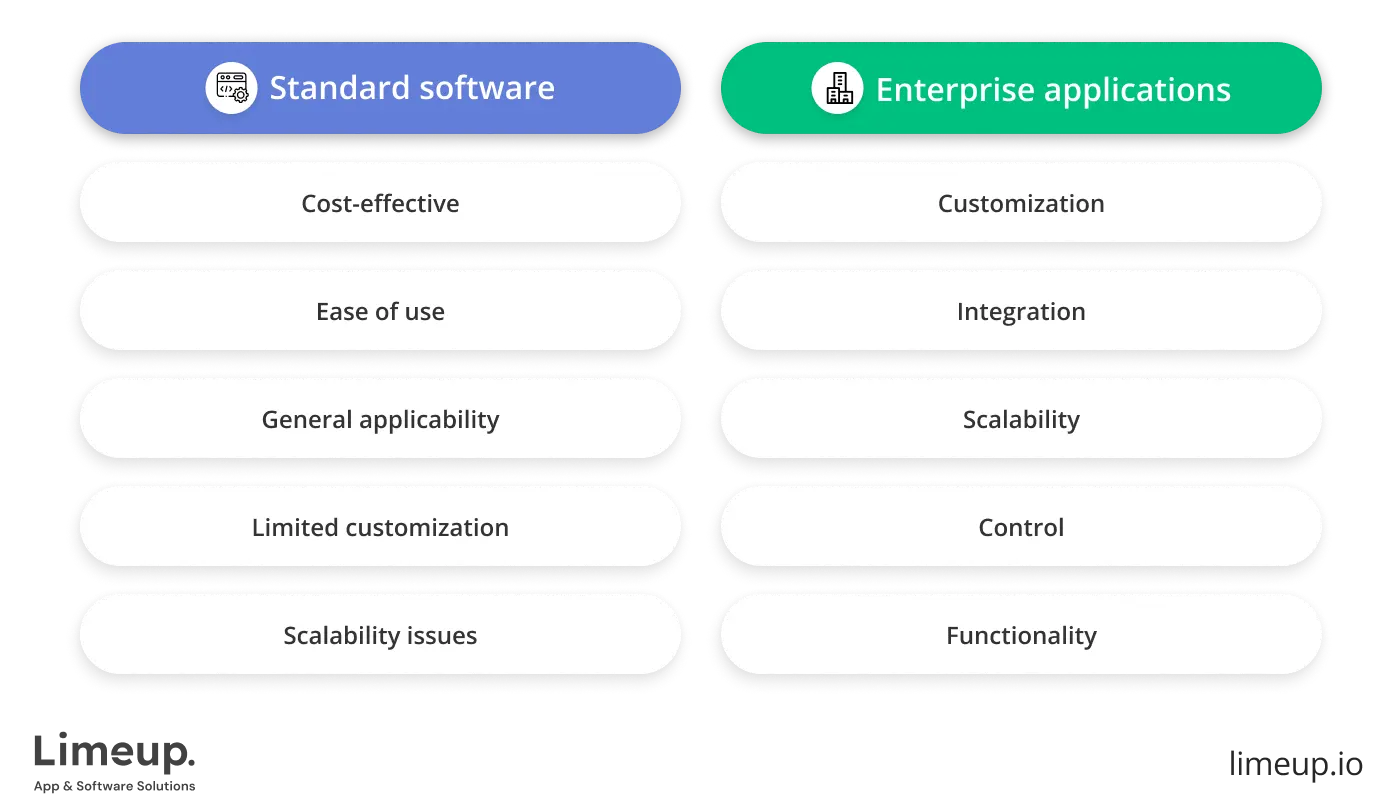
However, the scope of customization and scalability is limited in any off-the-shelf software. It may not fit all that well to unique business processes, which in turn may cause inefficiencies.
Key features:
- Cost-effective: Less upfront investment.
- Ease of use: Easy to install; very little configuration is required.
- General applicability: A general product developed for a wide audience.
- Limited customization: Would not meet all specific business requirements.
- Scalability issues: The scalability with growing business demand would be difficult.
Enterprise applications, however, require a much more prolonged and detailed development process: elaborate requirement gathering, customization and integration with existing applications. Because of the higher degree of control and flexibility this type of software provides, enterprises can ideally adjust their tools to their operational workflow.
The best enterprise applications are those that offer advanced functionality and scalability for larger organizations or those with specific needs. During the period you build enterprise software, despite the upfront investment and implementation time may feel like a tall order, the long-term gains in efficiency, productivity, and business alignment often tip the scales in favor of overcoming these initial obstacles.
Key features:
- Customization: Made to order to satisfy the desires of the business.
- Integration: An effortless shift between current systems.
- Scalability: Easy scaling to accommodate expanding businesses.
- Control: More control over functions and procedures.
- Functionality: Made to improve particular business processes.
How to create enterprise software is a multilevel process that requires meticulous planning and execution. Each step, from the stage of requirement gathering to implementation, needs proper care and attention; this will involve collective efforts by different stakeholders. Such an organized investment will provide them with powerful, customized solutions that bring efficiency in line with their unique goals.
Trends in software development for enterprise
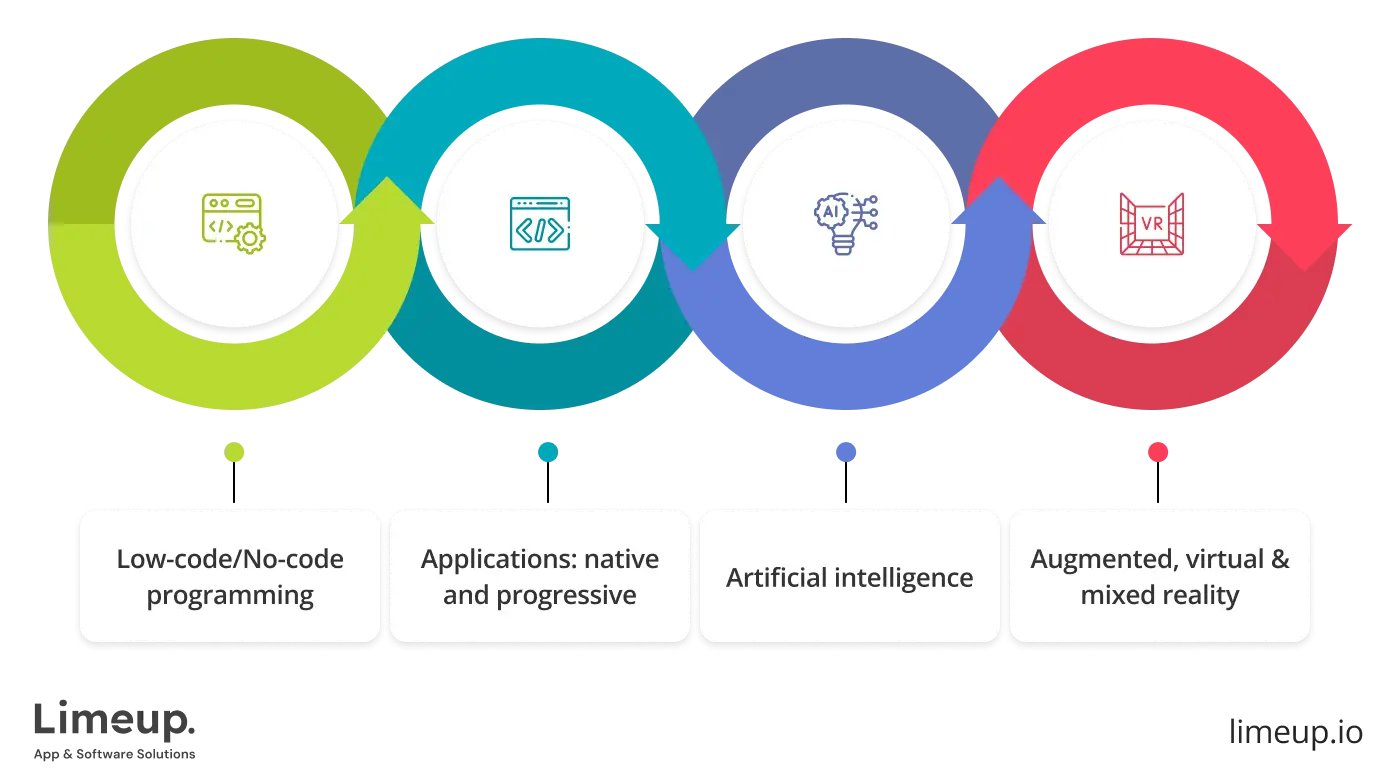
Low or no-code programming has been gaining ground and is going to change the course of the software development industry. This new methodology empowers users who cannot write code to develop their own applications and thus minimizes the potential gap of software engineers. By 2024, nearly two-thirds of programming initiatives will leverage low-code for business applications.
Nowadays, drag-and-drop editors are very popular. Low-code programming has earned such a significant reputation. Now, non-programmers are able also to develop enterprise software applications without coding. Moving ahead in 2024, such methods of application creation are going to gain more ground. Such low-code or no-code corporate software app development will help businesses lower costs.
Further, it is estimated that by 2033, the no-code AI platform market will reach $8,903 million. It is projected to reach approximately USD 45.5 billion by 2026 for a current revenue value of USD 13.2 billion.
Presently, enterprise software development trends are dominated by native apps. It is being considered because it helps companies to target existing and future smartphone users. In comparison to the Android and iOS platforms, it improves customer experience and brand performance drastically.

The newest of these types of applications is the Progressive Web App. Commonly called PWAs, the designs focus and enhance CX. Any top mobile app development company can speak to the advantages of PWAs with regard to load times that are fast, increased functionality, lower bounce rates, the ability to run on devices natively as windowed applications and a much greater possibility of browser versions of apps that have limited restrictions.
The progressive web apps would be the future of development for enterprise software in 2024 when things are set to be taken to the next level.
AI is the newly found trade anchor that is mostly applied in matters that deal with cybersecurity since it involves detecting activity that turns out to be malicious and software that identifies possible dangers quickly. It identifies data breaches and questionable IP addresses.
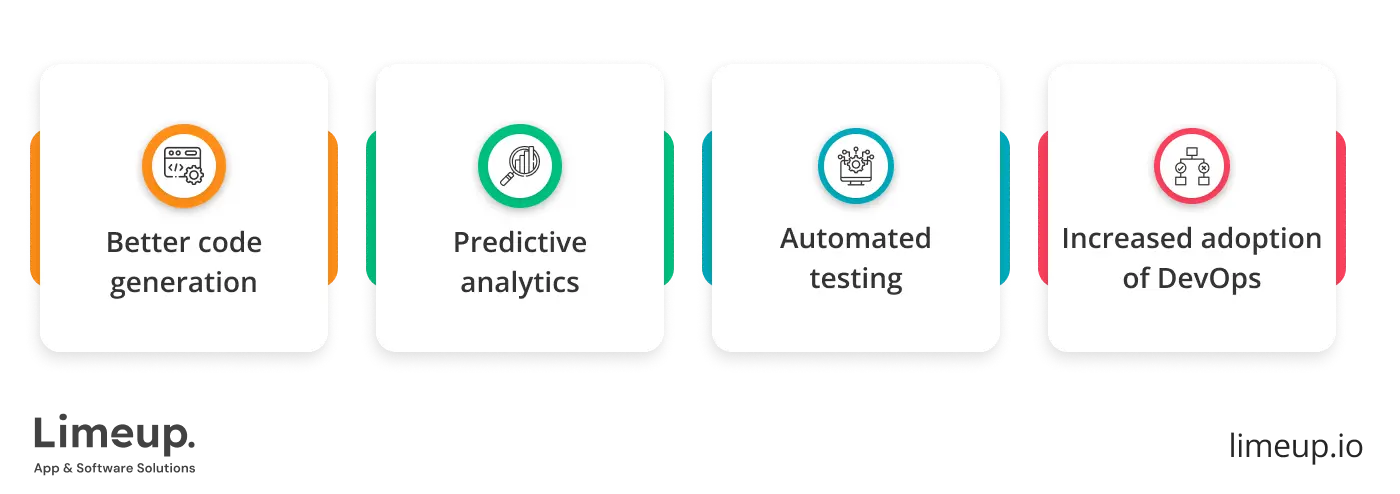
Cybersecurity-focused businesses could ride the wave of AI as the latest trend in software. Besides, the augmentation of artificial intelligence is a necessary part of hyper-automation increasing functionality and quality of life. Finally, AI-driven automation takes the grunt work out of repetitive tasks, freeing up human resources for more strategic projects and high-impact projects.
Ever since the day that augmented reality technology was conceived, it has enjoyed huge popularity. According to expert opinion, this technology is going to dominate the industry even in 2024. In fact, its wide application across industries like manufacturing, retail and navigation contributed to its huge success.
The potential of augmented reality technology will be blown out of the water when AI-layered ad filters and formats are rolled out across social media giants like Instagram and Facebook. If its virtual makeover is adding an entirely new level of complexity, corporate software development must keep up.
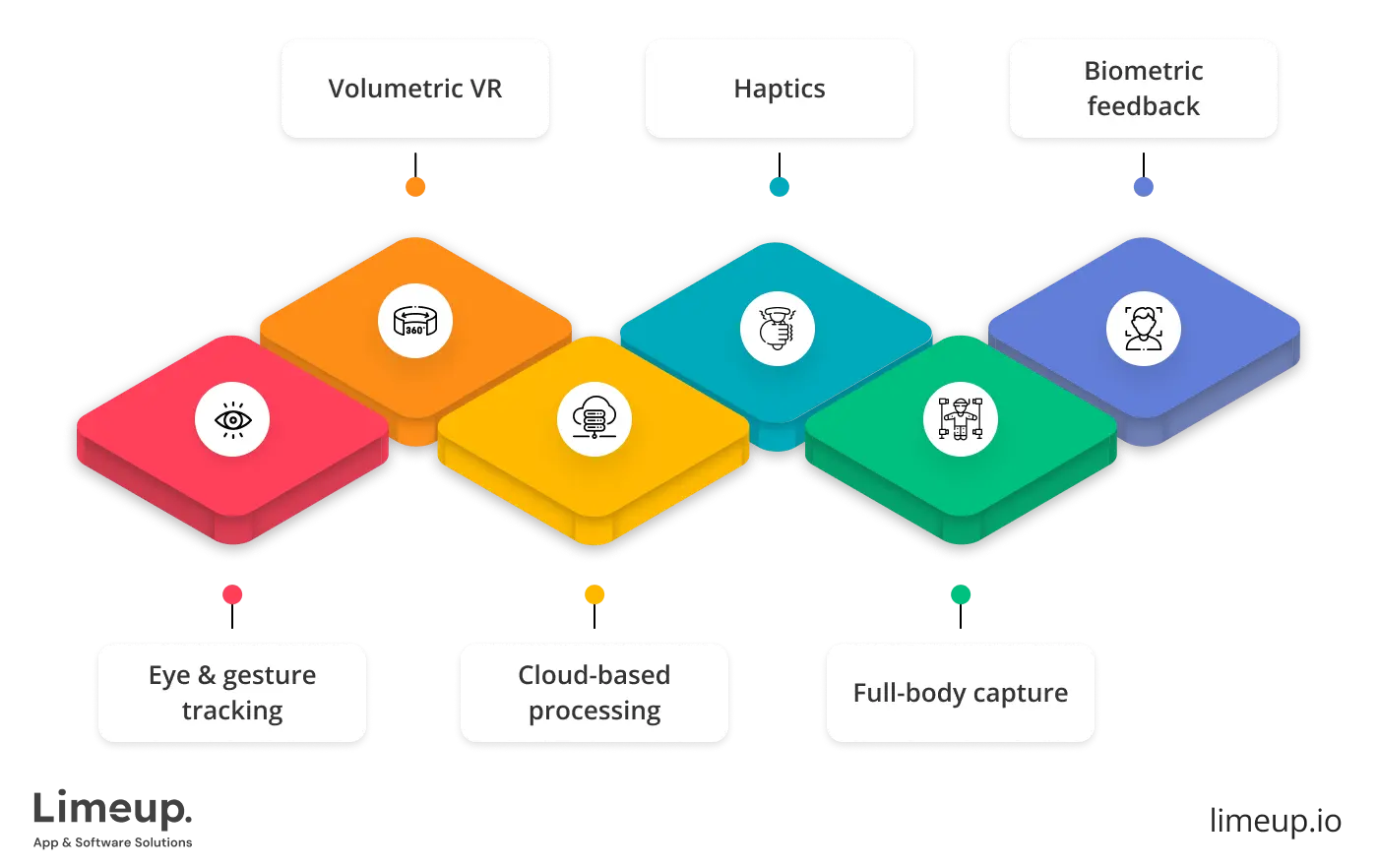
Much of this growth can be attributed to the enormous gains made from VR. Virtual reality is one of the latest creations in software development that gives consumers an immersive experience with progressing computer visions and a first-person point of view.
Indeed, many enterprises are looking at the potential of VR and searching for ways to negotiate challenges posed in several diverse fields. The applications of virtual reality can be applied not only in the media and games industry but proved to be useful in several other fields like training and education. Many educational institutions use simulations using virtual reality in the classroom for schools.
The same has been the case with corporations — user-centricity has remained the prime priority of various organizations in the recent past. This alone serves as a hefty motive for corporations to tilt toward VR technology.
Today, AR and VR have wide applications in a number of industries most notably, travel and tourism, gaming, healthcare, defense, architecture and construction. Software development services could be vital in all of these industries for the appropriate execution of MR technologies.
MR is one tremendous advantage in the current competitive business world when enterprises are always on the lookout for ways to differentiate. It represents an enabler of unparalleled magnitude when it comes to enhancing business software offerings beyond recognition.
How to find enterprise software developers?
Software for corporations is an investment big enough to affect how your staff and customers will interact daily. The development process itself takes from four to twelve months and during that period, the newly hired team will work very closely with your employees.
Considering all this, treatment of the same thought and care while bringing employees into your company needs to be accorded to hiring developers for business software development. The following procedures can act as a reference towards finding an enterprise software development team that will collaborate well with your business in producing quality work.
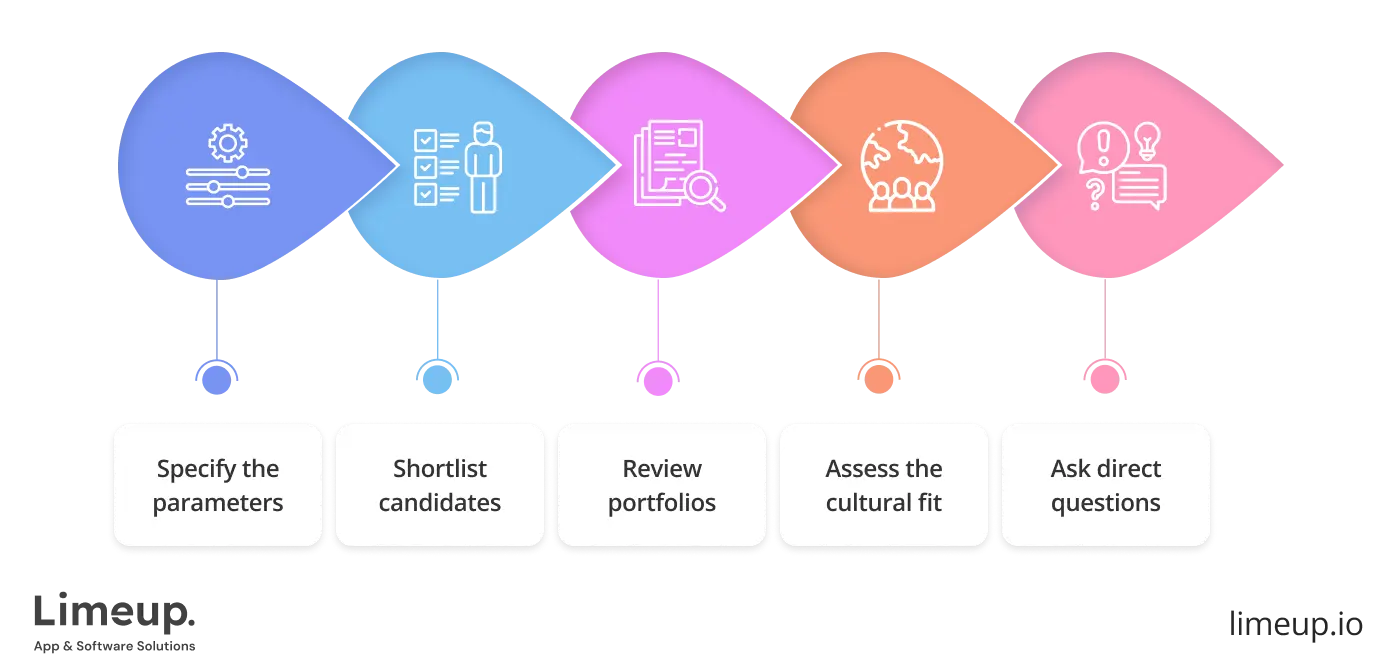
- Specify the parameters, schedule and spending plan. Define the issues that your new software must resolve, your timeframe for needing a solution and the budget you have in mind. Choosing an experienced enterprise software development company in the UK will help you secure a reliable partner who understands your industry and can deliver scalable, secure solutions tailored to your needs.
- Shortlist candidates. Look up enterprise software product development companies online and ask your peers for referrals. Important information to look for in client feedback when using B2B service review platforms such as Clutch or GoodFirms comprises longevity of partnerships, quality of communication, location and time zone pricing.
- Review portfolios. The moment you have a pool of prospects, review portfolios against your requirements to short-list candidates. The ideal partners will show a history of dealings with businesses of a similar size, experience in your sector and success using state-of-the-art technologies that your project is going to be requiring.
- Assess the cultural and communication fit. Outsourced collaborations work best if everyone can communicate well and the new team supports the fundamental values of your company, much like when you develop enterprise software with a single, cohesive candidate.
- Ask direct questions. Devise your question around how each team works on a day-to-day basis and ask about development procedures, testing procedures, security practices, how to document things and how maintenance is approached.
Sorting through potential partners could be a real uphill battle — with so many options to sift through, it’s a time-consuming process.. Limeup excels in delivering innovative, scalable and secure solutions tailored to your business needs. Schedule a consultation with Limeup to explore how we can transform your enterprise operations and propel your business forward.
Summary
Corporate software development is therefore a very valuable investment that can dramatically improve the operations of any company towards long-term success. Be aware of the different stages that range from demand collection to deployment and maintenance and you can rest assured of an easy path from conception to conclusion.
Keeping up with the newest developments in AI, cloud computing and low-code programming will give your company a competitive advantage.
A good development partner will ensure reliable scalable and secure software production that meets all of your unique requirements. The result of this decision will define how your business will operate. A team that has been picked appropriately will be in perfect coherence with the goals and objectives of your firm, ensuring that the software will increase output and effectiveness.
In business software development, proper knowledge and its getting-ready process is winning half the battle. You are able to easily cope with the production of software by keeping up with the trends of the industry and choosing the best enterprise software development team in a systematic way. If you make the correct decisions today, you shall be on the right path towards a better and more productive tomorrow.

